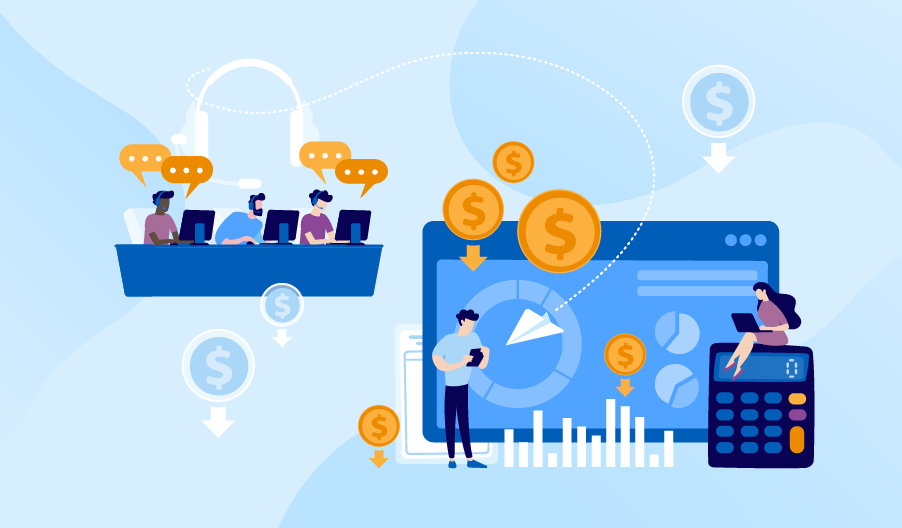“Am I Spending Too Much?” – Discussing Customer Service Cost
Editor’s note: Anastasia shares how customer service managers can evaluate their team's efficiency and lists ways to help bring down the cost of customer service. If you’re interested in a more in-depth look at your customer service costs, you are welcome to reach out to ScienceSoft’s customer service consulting team.

If you are a customer service manager, you should be able to tell how much your organization is spending on customer service. But how do you tell if those costs are indeed worth the output you’re getting? And, since your bosses probably don’t like hearing about increasing your team's budget, how do you keep pushing your customer service quality higher with the same – or even smaller – costs? Fortunately, there is a way to answer these questions and, as always, it’s all about customer service software.
Some stats before we proceed
|
It costs 5 to 25 times more to attract a new customer than retain an old one (source) |
A 5%-increase in customer retention rates yields over 25% more profit (source) |
|
|
Note: this proves that customer service should be viewed as a source of cost reduction and profit enhancement because it builds customer loyalty. |
||
|
US businesses lose $62 billion annually due to bad customer experiences (source) |
One poor experience makes 51% of customers prefer your competitors (source) |
|
|
Note: it could be substantially less, if the companies employed quality customer service. |
Note: this shows the true scale of costs your company can incur due to poor customer service. |
|
“How much is too much?” – evaluating your cost-effectiveness
The biggest trick in calculating ROI of your customer service efforts defining how much money your org gains through your customer service activity because there’s no distinct output like in sales or marketing. And since money saved is money earned, you should investigate the amount of costs that customer service helps to reduce/avoid and also factor it in the equation.
Besides customer service ROI, you should also look into customer retention and customer satisfaction. These rates indirectly show whether your customer service activity is helping your org to avoid excessive customer acquisition costs (remember relevant stat from above?) and whether there is any probability of word-of-mouth marketing.
The ideal values for these metrics (ROI, retention, CSAT) vary greatly from org to org depending on company size, industry, country and other factors but, naturally, you should try to push them as high as possible. To do that, you need to practice data-driven customer service management which obviously stems from monitoring your customer service metrics using data analytics.
You can analyze your customer service data in three ways:
- Run and check relevant reports inside your customer service software (if it supports dedicated functionality).
- Carry out analytics by hand in spreadsheets (this is the cheapest, most labor-intensive and least reliable way).
- Use your corporate BI solution or its equivalent to look at data in more detail by, for example, combining data from your customer service solution with accounting data.
Option 3 is what we at ScienceSoft usually recommend to our clients. Technically, it requires an integration between your customer service solution and your BI solution (or its equivalent) with certain ETL processes set up.
“Can I pay less and get more?” – pushing your ROI up with tech
Using your customer service solution in the right way – which means tapping into its huge customer service automation potential – you can do more work, bring your costs down and, eventually, build up ROI. Here are some of the features to help you with that:
- Chatbots (letting AI-powered chatbots solve common issues of your clients slashes reply time, enables optimizing agent load, frees up agent time to solve less trivial cases and decreases agent burnout rates).
- Self-service portal (this allows optimizing agent load and decreasing agent burnout rates by letting customers solve some of their problems on their own through FAQs and communities).
- Agent intelligence (smart context-based tips for agents that help them find solutions faster and keep track of all interactions).
- Agent workspace (a feature that speeds up your agents’ work by providing all needed tabs and functions at a click).
- Automated workflows (settings within your solution that eliminate the necessity to perform some actions by hand, e.g. assign and escalate cases or send follow-ups and surveys).
- Email templates with auto-filled customer-specific info.
Are you sure your customer service software supports all this?
If your current solution doesn’t provide the features stated above, you will need to either have them custom-made or migrate to a different solution altogether. Obviously, these actions require additional spending but modernization and implementation ROI will definitely be worth it.
When it comes to choosing a customer service solution, I believe that, if your org runs sales and marketing besides customer service (and chances are very high that it does), you should use one comprehensive CRM platform for all three domains. This way, you have all your data in one place, which improves analytics results, and, as a bonus, eases up the cooperation between sales, marketing, and customer service teams. That is why we usually advocate choosing customer service software provided by one of market-leading CRM platforms, such as Dynamics 365 Customer Service and Salesforce Service Cloud. They support all above-listed features and have huge potential for high implementation ROI.
If you’re interested – and you should be – let us know.

